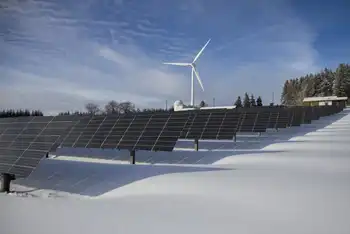Smoothing out wind power with giant battery
MINNESOTA - Utility Xcel Energy reports that a huge battery has worked effectively in smoothing out variable wind power, signaling how pockets of energy storage can help create a cleaner grid.
In 2008, Xcel started testing a 1-megawatt battery connected to an 11-megawatt Minnesota wind farm, the first direct wind-energy-storage project in the U.S.
The sulfur-sodium batteries from NGK Insulators of Japan are able store 7.2 megawatt-hours of electricity and, when fully charged, are able to power 500 homes for more than seven hours, according to Xcel. They weigh about 80 tons and are about the size of two semi trailers.
A sodium-sulfur battery from NGK Insulators installed on the grid in Charleston, W.Va., by utility American Electric Power.
The preliminary findings show that the technology can compensate for the variability of wind and ensure a steady balance between supply and demand, a task typically covered by natural gas plants.
The utility also used the batteries to store wind power during off-peak times and deliver it to the grid during peak times. Often, wind farms produce excess electricity at night because there isn't sufficient demand and the energy goes unused.
"We have proved that this technology can perform the functions of storage that we were looking for to help us manage the variability of wind energy on our operating system," said Frank Novachek, Xcel Energy's director of corporate planning, said in a statement.
But the batteries are expensive, costing $4 million, he told the Pioneer Press. Grid storage is seeing a surge in interest among utilities, but justifying the investment is challenging because many storage technologies are expensive and most utility regulations are designed for investments in power plants, not storage.
Xcel is planning to test a similar storage system with a large solar array near the Denver airport in Colorado. Energy storage attached to solar needs to be able to delivery bursts of electricity quickly, Novachek said.
"The solar application is different because solar output can drop drastically," Novachek told Finance & Commerce. "We've observed a solar output drop from 100 percent to 20 percent within one minute."
As part of the stimulus plan, the Department of Energy is partially funding a number of energy storage projects.
Also, the DOE announced that it will provide a $117 million loan guarantee to the Kahuku Wind Power project in Hawaii. The system will combine 12 2.5-megawatt turbines from Clipper Windpower and 30 megawatts of battery storage from Xtreme Power.
The DOE said that it approved a $17 million loan guarantee for installation of a 20-megawatt battery storage system from A123 Systems, which will be attached to the grid in New York. The storage will provide grid frequency regulation and allow the utility to use more solar and wind on the grid.
Related News

On the road to 100 per cent renewables
WASHINGTON - The Union of Concerned Scientists joined with COPAL (Minnesota), GreenRoots (Massachusetts), and the Michigan Environmental Justice Coalition, to better understand the feasibility and implications of leadership states meeting 100 percent of their electricity needs with renewable energy by 2035.
We focused on 24 member states of the United States Climate Alliance, a bipartisan coalition of governors committed to the goals of the 2015 Paris Climate Agreement. We analyzed two main scenarios: business as usual versus 100 percent renewable electricity standards.
Our analysis shows that:
Climate Alliance states can meet 100 percent of their electricity consumption with renewable energy by 2035. This holds true even with strong…




